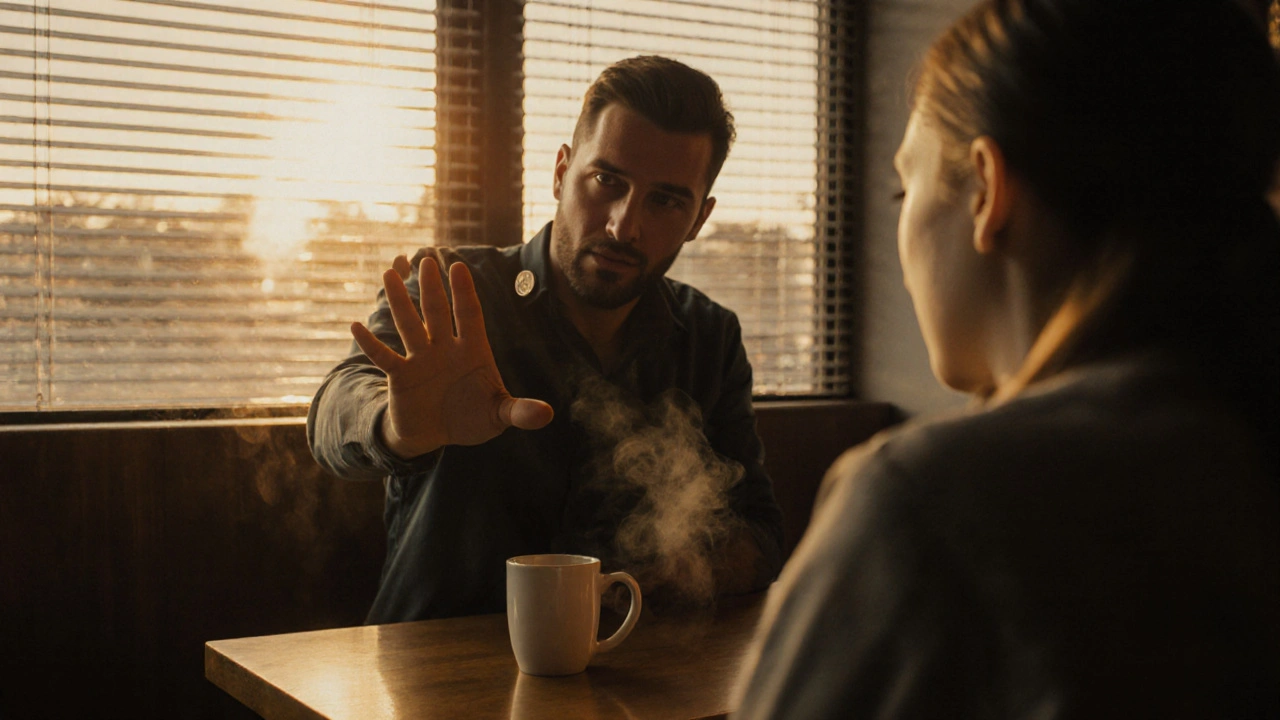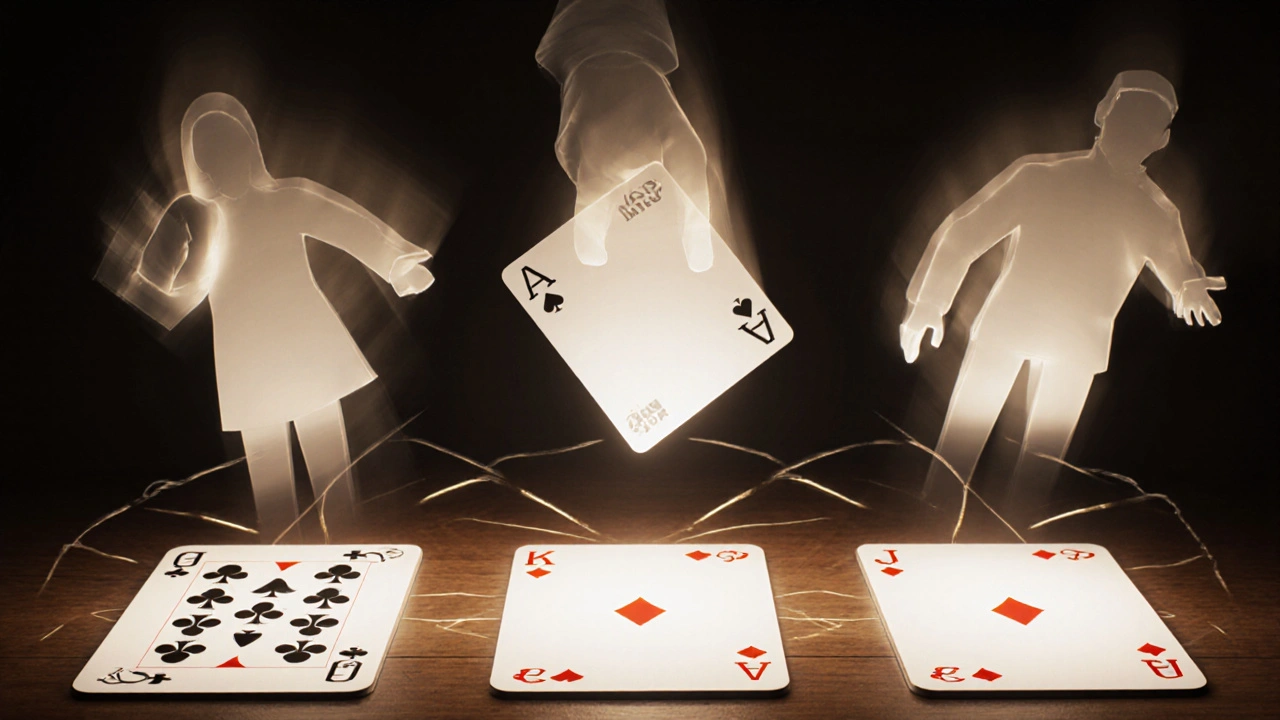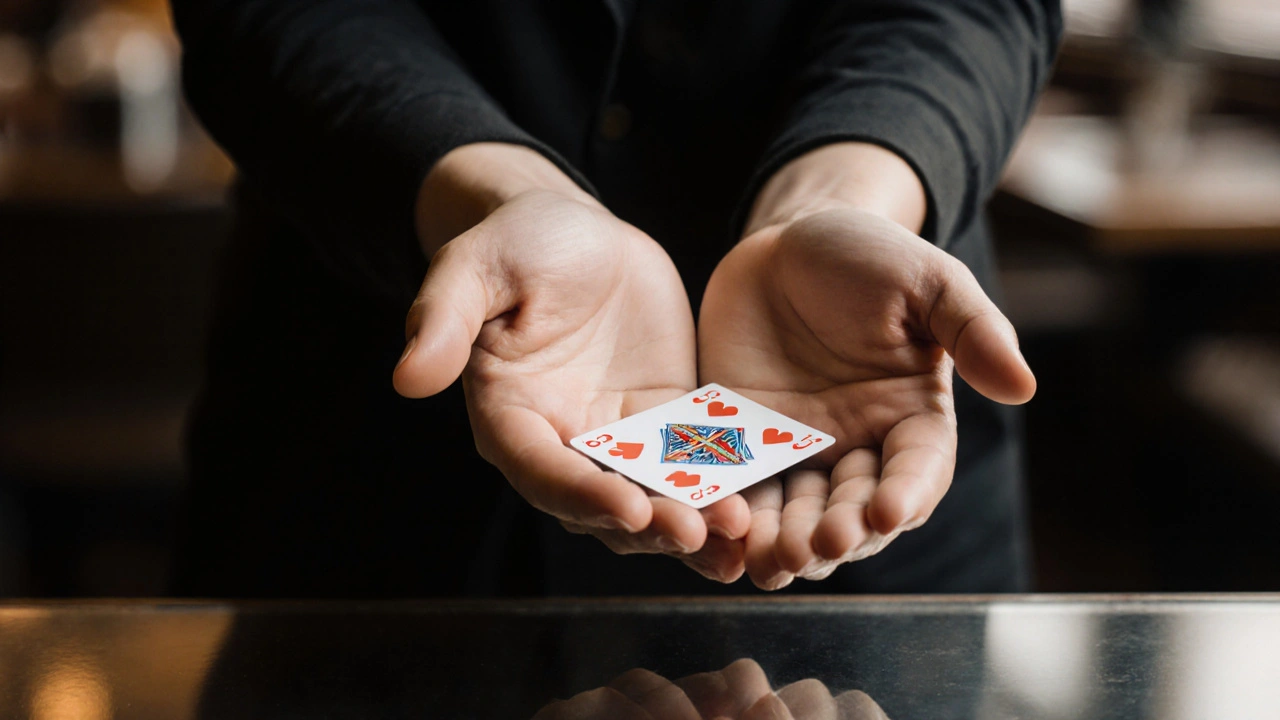Most people think magic tricks are about secret tools or fancy props. That’s not true. The real magic happens in your hands, your timing, and your confidence. You don’t need to buy a $300 kit to start. You don’t need to be a performer on stage. You just need to practice the right way-and know what most beginners get wrong.
Why Most People Fail at Learning Magic Tricks
People buy magic sets, watch YouTube tutorials, and try the same trick three times. When it doesn’t work, they quit. Why? Because they treat magic like a math problem. It’s not. Magic is performance. It’s psychology. It’s misdirection.
Take the classic three-card monte. You’ve seen it in movies. The dealer shuffles three cards, you pick one, and somehow the queen disappears. If you try it at home with real cards, you’ll likely mess up the shuffle or reveal the card too early. That’s not because you’re clumsy. It’s because you didn’t learn the timing-the pause before the move, the way you look away just a split second before the switch.
Studies in cognitive psychology show that people miss changes in plain sight when their attention is guided elsewhere. That’s the core of magic. You’re not hiding the card-you’re making them look at something else. And most beginners never learn how to control where the audience looks.
Start with One Trick: The Classic Palm
Forget learning ten tricks in a week. Pick one. Master it. The palm is the foundation of nearly every card trick. It’s when you hold a card in your hand without anyone seeing it. Sounds simple? Try it right now. Hold a playing card between your thumb and fingers. Now, pretend you’re holding nothing. Look at your hand. If you can see the edge of the card, you’re doing it wrong.
Here’s how to do it right:
- Place the card flat in your palm, face down.
- Curl your fingers slightly inward, letting your thumb rest naturally across the top.
- Press the card gently against your palm so it doesn’t bulge.
- Keep your hand relaxed. Tension gives it away.
- Practice in front of a mirror. Look at your hand from every angle. Can you see the card? If yes, adjust your grip.
Practice this for 10 minutes a day for two weeks. Don’t move on until you can palm a card while talking, walking, or reaching for a drink. That’s when it becomes invisible.
Learn the Power of Misdirection
Great magicians don’t move fast. They move at the right time. Misdirection isn’t about waving your hand. It’s about controlling attention. The best way to learn this is with a simple trick: the coin vanish.
Hold a coin between your thumb and index finger. Pretend you’re going to flip it into your other hand. But instead, let it drop into your palm while your other hand moves upward as if catching it. The audience’s eyes follow the motion-your empty hand. The coin stays hidden.
Now, here’s the secret: say something. Just say, “Watch this.” Or, “This is the part most people miss.” Even nonsense works. Your voice pulls their brain away from your hands. That’s the magic.
Try this with a friend. Do the trick. Ask them, “Where did it go?” Most will say, “I don’t know-I was watching your other hand.” That’s your win.

Card Tricks That Actually Work for Beginners
Not all card tricks are created equal. Some require years of training. Others? They work with minimal practice. Here are three that deliver real wow-factor:
- The Force: Make someone pick a card they think they chose freely. Use the classic “Hamman Force”-hold the deck face down, let them say “stop” as you slide a card out. They pick the one you want. No sleight needed-just timing.
- The Ambitious Card: Put a card in the middle of the deck. Make it rise to the top. Sounds impossible? It’s not. You just need to do a simple double lift (lifting two cards as one) and repeat it three times. Practice it slowly. It’s all about the rhythm.
- The Ten-Card Trick: Spread ten cards face down. Ask someone to pick one. You guess it. How? You secretly peek at the bottom card as you spread them. When they pick, you know the card next to it. You say, “I think it’s the one right after…” and you’re right. Simple. Effective. No palming.
These tricks don’t require expensive props. Just a deck of cards. And patience.
What to Avoid: Common Magic Mistakes
You’ll see online videos where magicians do flashy moves and call it “amazing.” But if you try them, they fall apart. Here’s what kills a trick before it starts:
- Looking at your hands. If you glance down while doing a move, the audience will too. Keep your eyes on theirs.
- Over-explaining. Saying, “Now I’m going to make the card disappear,” ruins the surprise. Let the trick speak for itself.
- Practicing in front of the mirror too much. Mirrors show you what you look like-not what the audience sees. Practice with real people. Watch their eyes.
- Trying to impress everyone. Magic works best in small groups. A trick that flops in front of 10 people might stun one person. Start intimate.
One of the most powerful tricks I’ve seen? A guy at a coffee shop made a quarter disappear into his coffee cup. No sleight. No gimmick. He just said, “Watch this,” and when the person looked, he dropped it. The person laughed, looked in the cup, and said, “Wait… how?” That’s the moment magic lives.

Practice Like a Pro: The 10-Minute Daily Rule
You don’t need hours. You need consistency. Here’s how to build real skill:
- Every morning, spend 10 minutes practicing one move. No more.
- Record yourself. Watch it. Where did your hand twitch? Where did your eyes look?
- Do it in front of a friend once a week. Ask: “Did you see anything?” If they say yes, fix it.
- Never practice when you’re tired. Magic needs focus. Do it when you’re alert.
After 30 days, you’ll notice something: people start asking you, “How did you do that?” That’s not luck. That’s mastery.
When You’re Ready: Perform, Don’t Show Off
There’s a difference between showing a trick and performing it. Showing is: “Watch this cool thing I learned.” Performing is: “Let me take you somewhere unexpected.”
Start small. At dinner. With your sister. At a bus stop. Don’t say, “I’m a magician.” Just say, “Want to see something weird?” Then do your trick. No fanfare. No music. Just you and the moment.
The best performances happen when no one expects it. That’s when the magic sticks.
What Comes Next
Once you’ve mastered one trick, pick another. Then another. But don’t chase the flashy ones. Stick with the classics. The ones that have worked for 100 years. The ones that rely on human behavior, not gadgets.
Eventually, you’ll stop thinking about the move. You’ll think about the person. Their smile. Their pause. Their question. That’s when you’re not just doing magic-you’re creating wonder.
Can I learn magic tricks without buying special equipment?
Absolutely. Most beginner magic tricks use everyday items: playing cards, coins, rubber bands, or even a napkin. The classic palm, force, and coin vanish require nothing but your hands. You don’t need a magic kit to start-just a deck of cards and patience.
How long does it take to get good at magic tricks?
You can learn a simple trick that impresses people in under a week with daily 10-minute practice. But real skill-where your moves look natural and your timing is flawless-takes 3 to 6 months of consistent practice. It’s not about speed. It’s about repetition and observation.
Why do magic tricks fail even when I do them right?
Most often, it’s not the move-it’s the delivery. If you look nervous, rush the action, or explain too much, the trick breaks. Magic lives in silence and timing. Practice the move until it’s automatic, then focus on your expression and voice. Your audience should feel like they’re part of something secret, not watching a demonstration.
Is magic more about skill or showmanship?
It’s both, but showmanship wins. A poorly executed trick with strong presence can amaze. A perfect move with no confidence will fall flat. People remember how you made them feel-not whether your finger slipped. Work on your presence as much as your technique.
Can kids learn magic tricks too?
Yes, and they often learn faster than adults. Kids aren’t overthinking the mechanics-they’re focused on the surprise. Start them with simple tricks like the disappearing coin or the rubber band switch. The goal isn’t perfection-it’s wonder. Magic builds confidence and observation skills in children.
If you’ve made it this far, you’re already ahead of 90% of people who try magic. You’re not looking for shortcuts. You’re looking to understand. That’s the real secret.


Ben De Keersmaecker
October 27, 2025 AT 23:24The palm technique is way harder than it looks. I tried it for a week and kept catching the edge of the card in my peripheral vision. Turns out, relaxing your thumb is the key-I was gripping like I was holding a live wire. Now I do it while scrolling through memes and no one notices. Magic is just stealthy hand yoga.
Also, never practice in front of a mirror. I did that for two weeks and ended up looking like a nervous accountant trying to hide a stack of cash. Real people don’t stare at their own palms. They stare at your face. Watch their eyes, not your fingers.
Johnathan Rhyne
October 29, 2025 AT 07:00Let me be the first to say this: magic isn’t psychology-it’s sleight-of-hand theater. You’re telling people to look away while you commit a crime against physics. Calling it ‘misdirection’ makes it sound like you’re running a TED Talk, not palming a queen of hearts.
Also, the ‘ten-card trick’? That’s not magic, that’s cheating with a side of smugness. If you’re peeking at the bottom card, you’re not a magician-you’re a card-counting gremlin with zero integrity. Real magic doesn’t need loopholes. It needs finesse. And if you’re relying on a ‘Hamman Force,’ you’re just manipulating people’s hesitation. That’s not wonder-that’s psychological manipulation with glitter.
Jawaharlal Thota
October 30, 2025 AT 09:03Ben, you’re absolutely right about the mirror thing-I made that same mistake for months. I thought if I could do it perfectly in the mirror, it would translate to real life. But the mirror doesn’t care if you’re nervous, or if your voice cracks, or if your knee shakes when you lean forward. Real audiences do. They feel your energy. That’s why the 10-minute rule works: it’s not about perfection, it’s about embedding the motion into your muscle memory so your body forgets it’s doing something secret.
And Johnathan, I hear you about integrity, but let’s not confuse ethics with art. The Hamman Force isn’t manipulation-it’s collaboration. The spectator thinks they chose the card, but they were guided by rhythm, silence, and timing. That’s not deception, it’s co-creation. Magic isn’t about hiding the truth-it’s about revealing wonder through carefully crafted illusion. And if you think peeking at the bottom card is cheating, then you’ve never seen a kid’s face light up when you guess their card without touching it. That moment? That’s worth a little ‘loophole.’
Lauren Saunders
October 31, 2025 AT 05:10Oh please. ‘The real magic happens in your hands’? How quaint. You’re romanticizing a parlor trick with the gravitas of a self-help guru. This isn’t enlightenment-it’s a party trick dressed up as philosophy. And ‘misdirection’? That’s just distraction with a thesaurus. If you’re calling this ‘psychology,’ then every magician is a cognitive scientist, and every child who says ‘look over there!’ is a Nobel laureate.
Also, ‘the classic palm’? There’s nothing classic about it. It’s been done since the 1800s. If you’re impressed by holding a card in your palm, you’ve never seen real illusion. Try Houdini. Try David Blaine. Try something that doesn’t require a deck of Walmart cards and a mirror in your bathroom.
sonny dirgantara
November 1, 2025 AT 10:07Nathan Jimerson
November 2, 2025 AT 13:52Ben, your point about practicing while walking or reaching for a drink? That’s the golden rule. I taught my 8-year-old nephew the palm last weekend. He didn’t care about perfect technique-he just wanted to make his little sister gasp. And when he did? She screamed, ‘How did you do that?!’ and he just grinned like he’d just invented time travel.
That’s the real win. Not the move. Not the trick. The look on their face. That’s why I keep doing this. Not to impress. Not to be ‘good.’ But to make someone feel like magic is real-even for a second.
Janiss McCamish
November 3, 2025 AT 02:52Johnathan is wrong. The Hamman Force isn’t manipulation-it’s choice architecture. You’re giving someone the illusion of freedom while guiding them. That’s not unethical. It’s storytelling. Magic isn’t about truth. It’s about experience.
And yes, the bottom-card peek works. So does the ‘force’ in card games. It’s not cheating. It’s performance. If you can’t tell the difference between a magician and a con artist, maybe you’re the one who needs to look harder.
Richard H
November 4, 2025 AT 12:44Y’all are overthinking this. Magic’s just a distraction. You’re not teaching people psychology-you’re teaching them to look the wrong way. And if you’re spending 10 minutes a day on this, you’ve got too much free time.
Real men don’t practice palming cards. Real men make people believe they’re invisible with a glance. That’s what the military taught me in Afghanistan. You don’t need a deck of cards. You just need to know when to blink.
Also, the ‘ten-card trick’? That’s a con. I’ve seen it done by street hustlers in Vegas. Don’t call it magic. Call it hustle.
Kendall Storey
November 4, 2025 AT 15:34Let’s reframe this: magic isn’t a skill-it’s a feedback loop. You practice the move → observe the reaction → adjust your timing → repeat. That’s iterative design, baby. And if you’re not recording yourself, you’re flying blind. I use a phone tripod and watch my micro-expressions. The second I glance down? I reset. No exceptions.
Also, the coffee shop quarter trick? That’s peak UX. Minimal friction, maximum surprise. No setup, no props, no script. Just presence. That’s the future of magic: ambient illusion. You don’t need a stage. You need a moment.
And yes, kids learn faster. They’re not burdened by the need to ‘be good.’ They just want to see the reaction. We should all be more like that.
Ashton Strong
November 5, 2025 AT 11:30It is with profound respect for the art of illusion that I offer this reflection: the discipline of magical performance, when approached with diligence and humility, cultivates not only manual dexterity but also emotional intelligence. The act of mastering the palm, for instance, necessitates the suppression of anxiety, the regulation of respiration, and the cultivation of nonverbal rapport with one’s audience. These are not trivial skills; they are foundational to human connection.
Moreover, the notion that magic is merely ‘misdirection’ underestimates its capacity to evoke awe-a rare and increasingly endangered emotional state in our hyper-rational age. To perform magic is to invite others into a sacred space of wonder, however fleeting. One does not merely learn a trick; one becomes a steward of mystery.
Therefore, I implore all practitioners: do not reduce this art to mechanics. Honor its lineage. Respect its silence. And above all, remember: the greatest illusion is not what you hide-but what you reveal about the human spirit.